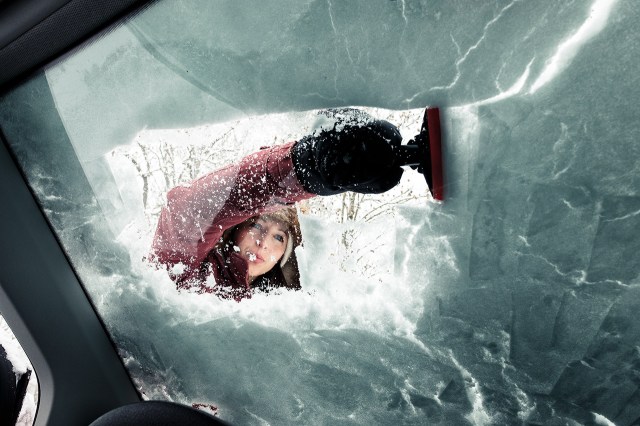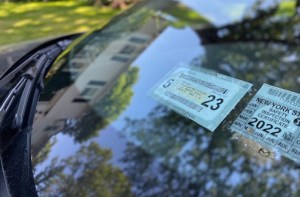Driving a car covered in snow and ice is exceedingly dangerous. The accumulation can block windows, obstructing your view of the road and surroundings. Potentially even more hazardous is the possibility of sheets of snow and ice dislodging from the vehicle while it’s in operation. This could cause serious injury to others and damage to property. For these reasons and others, it’s illegal to drive with snow and ice on your car.
Every Northeast state has snow and ice removal laws on the books that prohibit operating a vehicle without removing significant accumulation. Here’s a look at snow removal laws by state.
Connecticut
Connecticut is one of a handful of Northeast states with a specific law regarding snow and ice removal from vehicles. The statute reads, in part, that a driver, “shall remove any accumulated ice or snow from such motor vehicle, including the hood, trunk and roof of such motor vehicle, so that any ice or snow accumulated on such vehicle does not pose a threat to persons or property while the vehicle is being operated on any street or highway of this state.” The law also clarifies that drivers will not be cited if the snow accumulation began while the vehicle was in operation.
The fine for violating Connecticut’s snow removal law is $75. However, if failure to comply with the law results in personal injury or property damage, the fine escalates to a minimum of $200.
New Hampshire
New Hampshire statute 265:79-b, better known as Jessica’s Law, requires drivers to remove snow and ice from their vehicles. The law is named after Jessica Smith, a 20-year-old woman who died when a sheet of ice flew off a trailer and hit a truck that subsequently crashed into her car.
Neither snow nor ice are specifically mentioned in the law’s text, but it does state that it is illegal to drive a vehicle, “in a manner that endangers or is likely to endanger any person or property.” The fine can range from $250 to $500 for the first offense and $500 to $1,000 for subsequent offenses.
New Jersey
The Garden State is another with a snow-specific law on the books. Section 39:4-77.1 of New Jersey’s statute reads, “Each driver of a motor vehicle operated on a street or highway in this State shall have an affirmative duty to make all reasonable efforts to remove accumulated ice or snow from exposed surfaces of the motor vehicle prior to operation, which surfaces shall include, but not be limited to, the hood, trunk, windshield, windows, and roof of the motor vehicle.”
The statute goes on to state that a law enforcement officer can stop a driver if they believe the accumulated snow or ice poses a threat to other people or property. Violating the law can result in a fine between $25 and $75 regardless of whether the snow or ice becomes dislodged from the car.

Massachusetts
Unlike some other Northeast states, Massachusetts does not have a law specifically addressing snow accumulation on cars. However, the issue falls under the purview of other statutes.
Drivers who fail to remove snow and ice from their vehicles, for example, could be cited for driving with an unsecured load. Chapter 85, Section 35 of the Massachusetts law book states, “No person shall drive or move a motor vehicle on any way … if it is loaded with sand, gravel, loam, dirt, stone, rubbish or debris that could fall on other vehicles or on the highway and create litter or potential hazards to other vehicles, unless its load is fully and adequately covered.” If the snow is blocking a window, a driver could be cited for violating Chapter 90, Section 13, which prohibits impeding operation of a motor vehicle.
New York
Like Massachusetts, there is no specific New York State snow removal law (one was introduced in state Senate nearly a decade ago, but was never voted on). However, the Empire State does cover the issue with other traffic laws. For example, Section 1213 of New York’s Vehicle and Traffic Laws prohibits operation of a motor vehicle with an obstructed view.
Even if the windows are cleared, drivers need to also remember that, under state law, license plates must be visible as well as the illumination from head and taillights, something snow and ice accumulation can prevent.
Rhode Island
Rhode Island General Law 31-23-16 addresses snow and ice removal from cars. It states that, “No person shall drive any motor vehicle with any significant amounts of snow or ice upon the vehicle.” The statute goes on to clarify that “significant” can be defined as, “any amount of accumulation which might reasonably be expected, when blowing off the vehicle while driving, to obscure the vision of an operator of another vehicle.”
Similar to laws found in neighboring states, the Rhode Island statute exempts snow and ice accumulation that began while the car was in use.
Even with a snowless car, winter driving is especially difficult for new and improving drivers. Learn to become a lifelong safe motorist – under all conditions – with the AAA Defensive Driving Course.













